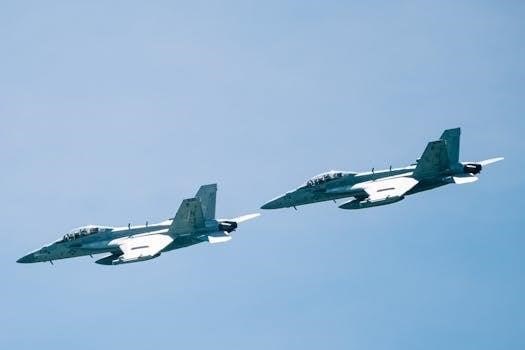The US Navy Diving Manual serves as a comprehensive guide for all underwater operations. It provides essential training and procedures for safe and effective diving practices. The manual has evolved since its first publication in 1916‚ ensuring the latest advancements are included.
Historical Overview of US Navy Diving Manuals
The US Navy’s commitment to safe diving practices is evident in the long history of its diving manuals. The first manual for training and operational guidance emerged in 1905‚ followed by the first book specifically titled “Diving Manual” in 1916. Since then‚ numerous editions have been published‚ each updating the content of the previous version to incorporate new technologies‚ procedures‚ and safety protocols. These manuals have grown significantly in size over the years reflecting the increasing complexity of diving operations and the accumulated knowledge in the field. For example‚ the manual initially documented standards for air diving and surface decompression procedures and later expanded to include mixed gas‚ closed-circuit‚ and saturation diving techniques. The 1973 edition was the first to document standards for saturation diving and use color.

Content and Structure of the Manual
The US Navy Diving Manual is organized into multiple volumes. Each volume covers specific aspects of diving‚ from principles and policies to specialized operations. This structured approach ensures clarity and ease of use.
Volume 1⁚ Diving Principles and Policies
Volume 1 of the US Navy Diving Manual lays the foundational groundwork for all diving activities. It establishes the core principles and overarching policies that govern naval diving operations. This volume delves into the fundamental physics and physiology of diving‚ explaining how pressure affects the human body. It also outlines essential safety protocols‚ administrative procedures‚ and the responsibilities of diving personnel. The content provides a comprehensive understanding of the theoretical basis for safe diving practices. Moreover‚ it details the regulatory framework within which all US Navy diving must operate‚ ensuring consistent and standardized procedures across all units and commands. This foundational knowledge is vital for all divers and diving supervisors.
Volume 2⁚ Air Diving Operations
Volume 2 of the US Navy Diving Manual is specifically focused on air diving operations‚ detailing the practical aspects of conducting dives using compressed air. This section provides comprehensive instructions on the use of surface-supplied air diving equipment and open-circuit SCUBA gear. It covers dive planning‚ pre-dive checks‚ in-water procedures‚ and emergency response protocols. This volume includes detailed information on air decompression procedures and tables‚ which are critical for preventing decompression sickness. Moreover‚ it addresses the specific challenges and considerations associated with air diving‚ offering best practices for various operational scenarios. This section ensures divers are well-versed in the application of air diving techniques safely and effectively.
Volume 3⁚ Mixed Gas Surface Diving
Volume 3 of the US Navy Diving Manual delves into mixed gas surface diving‚ a specialized area that addresses diving with gases other than air‚ typically helium-oxygen or nitrogen-oxygen mixtures. This section details the procedures for conducting surface-supplied mixed gas dives‚ which are often required for deeper or more complex underwater tasks. It provides guidance on the selection and use of appropriate gas mixes‚ as well as the necessary equipment and support systems. The volume includes comprehensive tables and procedures for mixed gas decompression‚ ensuring the safety of divers working at greater depths. Additionally‚ it covers operational considerations‚ safety protocols‚ and emergency procedures unique to mixed gas diving environments‚ which is crucial for deep underwater operations.
Volume 4⁚ Closed Circuit Diving
Volume 4 of the US Navy Diving Manual focuses on closed-circuit diving‚ a specialized technique involving the use of rebreather systems. This section comprehensively covers the procedures and protocols associated with closed-circuit underwater operations. It outlines the distinct characteristics of rebreather technology‚ including how these systems recycle exhaled gases‚ reducing gas consumption and allowing for extended dive times. The manual details the specific operational aspects of various closed-circuit systems‚ including pre-dive checks‚ maintenance‚ and emergency procedures. It is essential for divers using this technology to be trained in its specific requirements. This volume emphasizes safety considerations and risk management protocols unique to the closed-circuit environment‚ crucial for diver safety and mission success.
Volume 5⁚ Diving Medicine
Volume 5 of the US Navy Diving Manual is dedicated to diving medicine‚ a crucial aspect of ensuring diver safety and well-being. This section provides comprehensive information on the physiological effects of diving‚ including the impact of pressure changes on the human body. The manual details the diagnosis‚ treatment‚ and prevention of diving-related illnesses and injuries‚ such as decompression sickness and barotrauma. It also covers the procedures for administering first aid and emergency medical care in diving situations. This volume provides essential guidelines for medical personnel involved in diving operations. Furthermore‚ it emphasizes the importance of medical fitness assessments for divers and the management of pre-existing medical conditions. This section is a vital resource for promoting diver health and safety.

Key Aspects Covered in the Manual
The manual emphasizes diving equipment‚ safety‚ and decompression procedures. It also incorporates operational risk management for planning. Key areas include using equipment safely‚ understanding tables‚ and risk analysis.
Diving Equipment and Safety Procedures
The US Navy Diving Manual provides detailed information on diving equipment‚ including open and closed-circuit scuba‚ surface-supplied systems‚ and recompression chambers. It covers equipment selection‚ maintenance‚ and operational use. Safety procedures are also covered‚ emphasizing protocols for pre-dive checks‚ in-water operations‚ and post-dive routines. The manual stresses the importance of understanding how each piece of equipment functions and its limitations. It includes guidelines on proper donning and doffing procedures‚ and maintenance to ensure safe diving operations. The manual also discusses the use of tools and accessories‚ ensuring they have passed safety reviews and testing. The manual focuses on safety to prevent accidents and ensure the wellbeing of divers during all types of diving activities.
Decompression Procedures and Tables
The US Navy Diving Manual details crucial decompression procedures and tables essential for safe diving practices. It presents comprehensive guidelines for managing decompression obligations‚ which are vital for preventing decompression sickness. The manual contains detailed tables for air‚ nitrogen-oxygen‚ and helium-oxygen diving‚ providing specific decompression stops based on depth and bottom time. It includes procedures for both surface and in-water decompression. The manual addresses the use of different gases and their impact on decompression requirements. It also covers procedures for handling decompression sickness‚ including saturation diving and recompression treatment. Divers are instructed to strictly adhere to these tables and procedures to mitigate risks during ascent. The manual emphasizes proper planning and precise execution of decompression protocols.
Operational Risk Management (ORM)
The US Navy Diving Manual incorporates Operational Risk Management (ORM) as a fundamental aspect of dive planning and execution. This systematic approach aims to identify‚ assess‚ and mitigate risks associated with diving operations. ORM is integrated into all stages of diving‚ from pre-dive planning to post-dive procedures. The manual emphasizes the importance of proactively identifying hazards and implementing control measures to reduce potential harm. Divers are trained to use ORM tools and techniques to enhance decision-making and minimize accidents. The ORM process involves analyzing the mission‚ identifying risks‚ developing controls‚ and evaluating the outcomes. By applying ORM principles‚ the Navy ensures that diving operations are conducted with the utmost consideration for safety. This structured approach promotes a culture of risk awareness and proactive mitigation;

Updates and Revisions
The US Navy Diving Manual undergoes regular updates and revisions to incorporate new technologies and procedures. These updates ensure that the manual remains current and reflects the latest best practices in diving.
Revision 5 Comprehensive Update
Revision 5 of the U.S. Navy Diving Manual marked a significant and comprehensive update‚ incorporating the latest procedures and equipment utilized by military working divers. This extensive revision included a thorough review of all existing protocols‚ ensuring that the manual reflected the most current practices. A key element of this update was the formal integration of the Operational Risk Management (ORM) process into Navy dive planning. This addition emphasized safety protocols and risk mitigation strategies‚ highlighting the importance of a proactive approach to dive operations. This revision also served as a foundation for subsequent updates‚ setting a new standard for diving safety and procedure.
Revision 7 and Change A (2018)
The U.S. Navy Diving Manual’s Revision 7‚ further enhanced by Change A in 2018‚ represents a significant step in refining diving procedures. This update included substantial improvements‚ clarifications‚ and corrections to the previous edition. It ensured the manual remained current with the latest advancements in diving technology and safety protocols. The 2018 update provided optimized guidance for both surface-supplied and open and closed circuit SCUBA diving‚ as well as recompression chamber operations. This revision was meticulously crafted to provide divers with the most accurate and relevant information available‚ significantly improving the usability of the manual.

Availability and Access
The US Navy Diving Manual is available through publicly released publications. Resources can be found on the NAVSEA website‚ providing accessible information for diving professionals and enthusiasts.
Publicly Released Diving Publications
The US Navy makes various diving-related publications available to the public‚ offering a wealth of information on diving procedures‚ safety protocols‚ and equipment specifications. These publicly released documents often include extracts or full versions of the US Navy Diving Manual. They serve as valuable resources for civilian diving communities‚ researchers‚ and anyone interested in the technical aspects of diving. These publications can be accessed through various channels‚ including government websites and online databases‚ ensuring that the knowledge and expertise developed by the Navy are shared with a broader audience. The accessibility of these documents promotes safety and best practices within the diving industry‚ fostering a culture of informed and responsible diving operations. Many of these manuals can be downloaded in PDF formats.
NAVSEA Website and Resources
The Naval Sea Systems Command (NAVSEA) website serves as a primary hub for accessing the US Navy Diving Manual and related resources. NAVSEA‚ being the largest of the Navy’s system commands‚ plays a crucial role in maintaining and updating the manual. Their website provides access to the latest versions of the diving manual‚ along with other technical documents related to diving equipment and procedures. The site also offers information on updates‚ revisions‚ and safety protocols. This ensures that divers and other interested parties have access to the most current and accurate guidance. NAVSEA’s online platform is a critical tool for the dissemination of diving knowledge‚ promoting safety and operational excellence within the Navy and the broader diving community. It hosts a range of materials from manuals to related resources.
Application and Scope
The US Navy Diving Manual applies to all US Navy diving activities‚ both afloat and ashore. It provides guidelines for all Department of the Navy diving operations‚ with specific exclusions for Naval Special Warfare Command.
Application to US Navy Diving Activities
The US Navy Diving Manual is the primary source of guidance for all underwater diving‚ dive training‚ and manned hyperbaric system operations conducted by the United States Navy. This includes both surface-supplied and open and closed-circuit SCUBA diving‚ as well as recompression chamber operations utilizing air‚ nitrogen-oxygen‚ helium-oxygen‚ or 100 percent oxygen. It is applicable to all afloat and ashore diving activities‚ ensuring standardized procedures across the Department of the Navy. The manual’s comprehensive nature allows it to be the technical basis for many subsequent instructions and directives within the Navy’s diving community. Treatment for decompression sickness during saturation dives is also covered in the manual.
Exclusions for Naval Special Warfare Command
While the US Navy Diving Manual serves as the foundational guide for the vast majority of Navy diving operations‚ there are specific exclusions‚ most notably for the Naval Special Warfare Command (NAVSPECWARCOM). This command‚ due to its unique operational requirements and specialized mission sets‚ operates under different protocols and procedures that may deviate from the standard guidelines outlined in the manual. The manual explicitly states that its instructions do not apply to NAVSPECWARCOM. This ensures that the specialized diving activities conducted by this command can be executed effectively and efficiently‚ tailored to their specific needs and operational demands while maintaining the highest safety standards within their own framework.